Restaurant in Peace

A look back at bygone ‘Boro eateries
By Billy Ingram
Join us for a retrospective of Greensboro’s rich culinary legacy. Travel back in time to when just about every place someone dined in was locally owned. Patrons not only became friends with the restaurateurs, they were able to watch their children, who served them and ran the cash register, grow into adulthood.
Our journey begins in an era when farm-raised meats and just-picked produce were delivered directly each morning from farms to cafe back doors. Every dish was painstakingly prepared daily from generations-old recipes; adventurous innovators rose up with visions for what an increasingly younger clientele yearned for. Tuck in your bib and dig into the days shortly before the soulless mediocrity of an endless chain of corporate franchises hijacked America’s taste buds.
1) Manuel’s Cafe

© Greensboro History Museum
From the early 1920s to the mid 1950s, Manuel’s was the epitome of fine dining downtown, with fresh flowers and linen tablecloths. Men, of course, wouldn’t think of arriving attired in anything but a suit and white gloves were de rigueur for the ladies, though most folks of a certain class dressed like that when they left the house back then any way. Known for its rich, savory spaghetti and massive Western-style steaks, Manuel’s shared the block with Jefferson Standard’s West Market Street entrance. “We serve the very best!”
2) Cafe Mecca

© Greensboro History Museum
A little further down West Market during the ’30s and ’40s sat “Greensboro’s Most Popular Restaurant,” Cafe Mecca, serving seafood and steaks but pretty much offering the same menu items as every other local hash house. There was very little ethnic food available in town, but one notable exception was The Lotus Restaurant, launched in the 1930s and specializing in Chinese dishes, facing the Carolina Theatre on Greene Street.
3) Matthew’s Grill
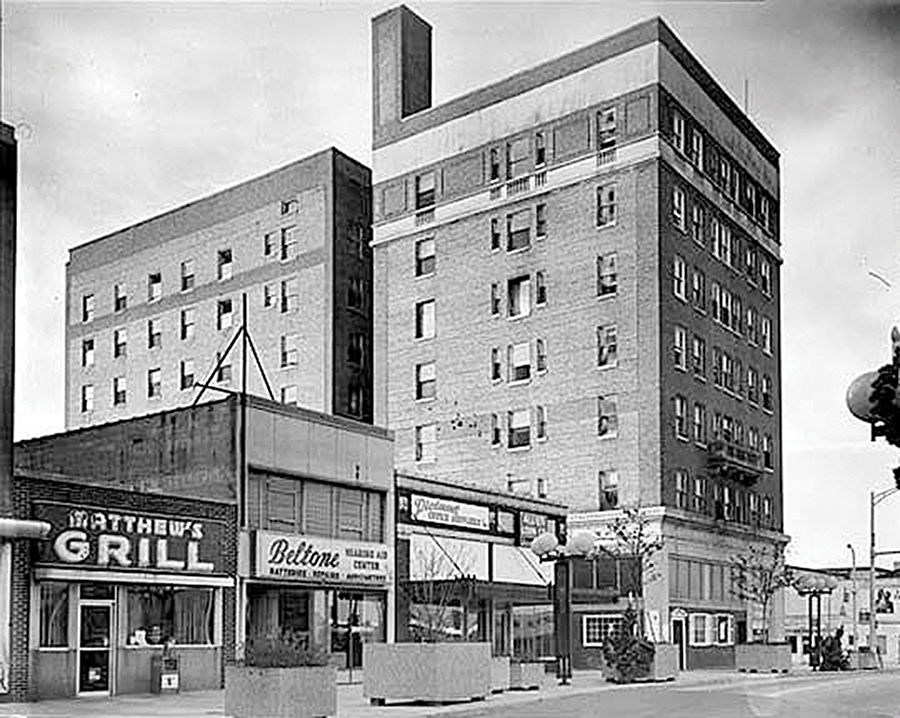
Almost every city eatery from the’30s into the ’80s was owned and operated by Greek immigrants, Matthew’s Grill, aka “The Right Place To Eat,” being no exception. Having learned the business at The Princess Cafe, his sister and son-in-law’s downtown mainstay on South Elm, owner-operator Minas Dascalakis bought Matthew’s, sandwiched between the Greensboro and O.Henry Hotels on North Elm, in 1953. For the next 36 years, that luncheonette’s counter served as a go-to spot for business leaders and city officials. Standard Southern fare dominated the menu — the Sunday Special in the ’60s was braised rabbit — but Dascalakis was always eager to whip up any off-menu Greek speciality a customer craved.
4) Your House
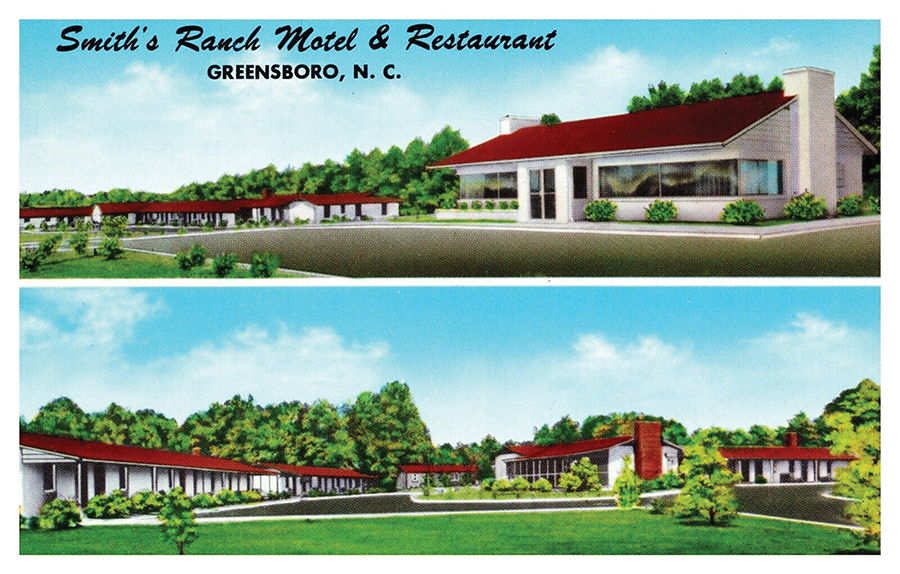
This always dependable, inexpensive diner began life in Greensboro in the mid-’50s, adjacent to the Journey’s End Motel on Battleground, and survived 55 years, long after that motor lodge gave way to a generic shopping center some four decades ago. In its heyday, the restaurant was part of a 12-unit chain founded by the Callicotts in Burlington in 1962. I was also partial to another house, Jan’s House, in that funky dilapidated strip mall on West Market, where you could imagine the chef was flat-topping hash browns between stints behind bars.
5) Ranch Restaurant
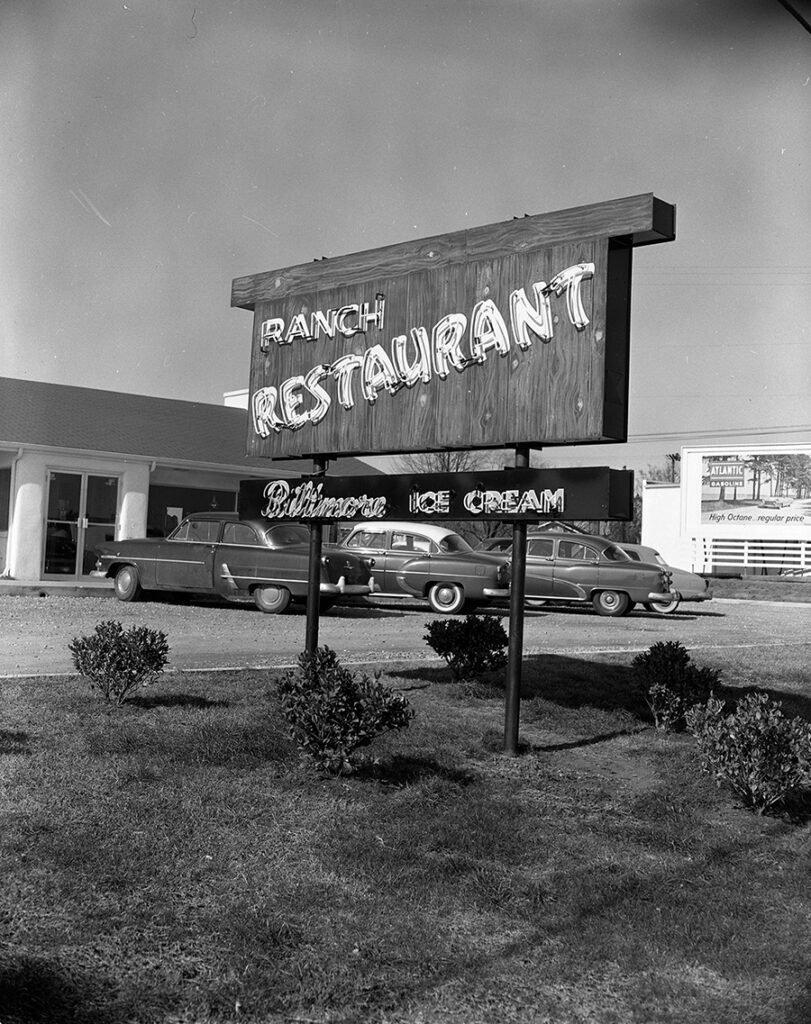
© Greensboro History Museum
Very much like the design and concept of Your House, The Ranch Restaurant was attached to Smith’s Ranch Motel on Randelman Road at what was then the edge of town near Interstates 40 and 85. In 1968, proprietor J. Howard Coble (no relation to U.S. Rep. Howard Coble of Greensboro, whose father was Joe Howard Coble) served up a complete club steak dinner, including salad, french fries and buttered roll for the princely sum of $1.65.
6) Southern Queen Hot Shoppe
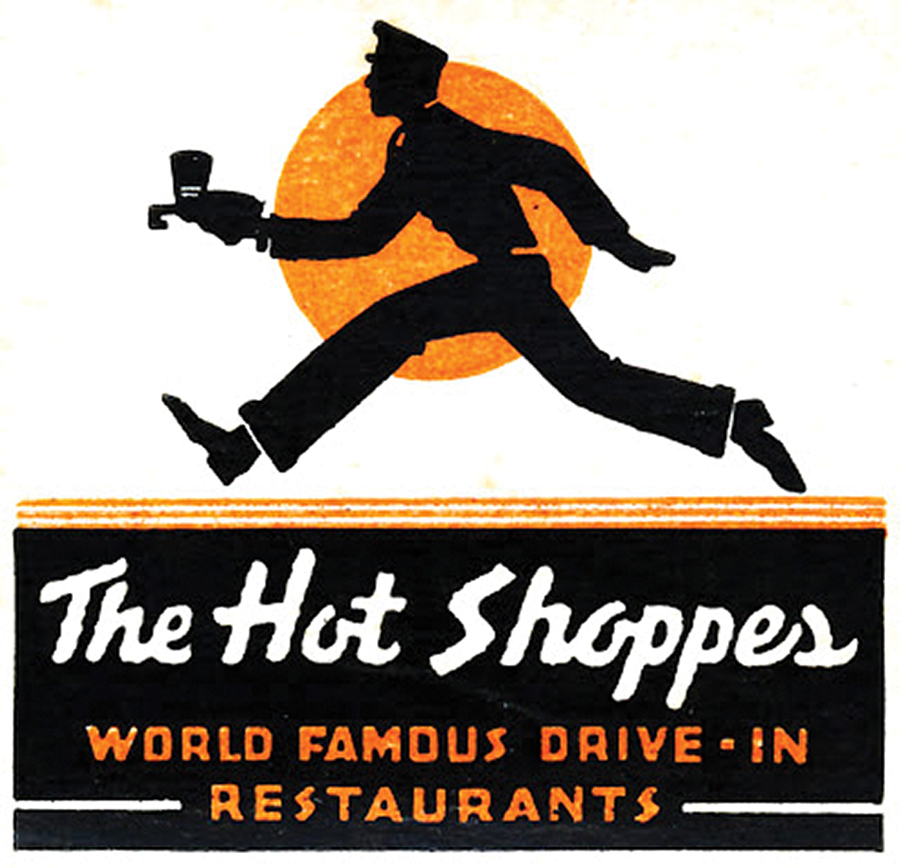
Ever notice that streamlined, train car-like building with a stainless steel exterior (recently painted over) attached to the side of La Bamba on Gate City Boulevard? Originally located across the street, this very rare example of a late-1940s Paramount built diner was constructed for Southern Queen Hot Shoppe, a drive-in hangout for post-war hipsters serviced by uniformed “curbers.” The Greensboro Hot Shoppe was one of 70 in seven states at the chain’s height.
7) Airport Restaurant
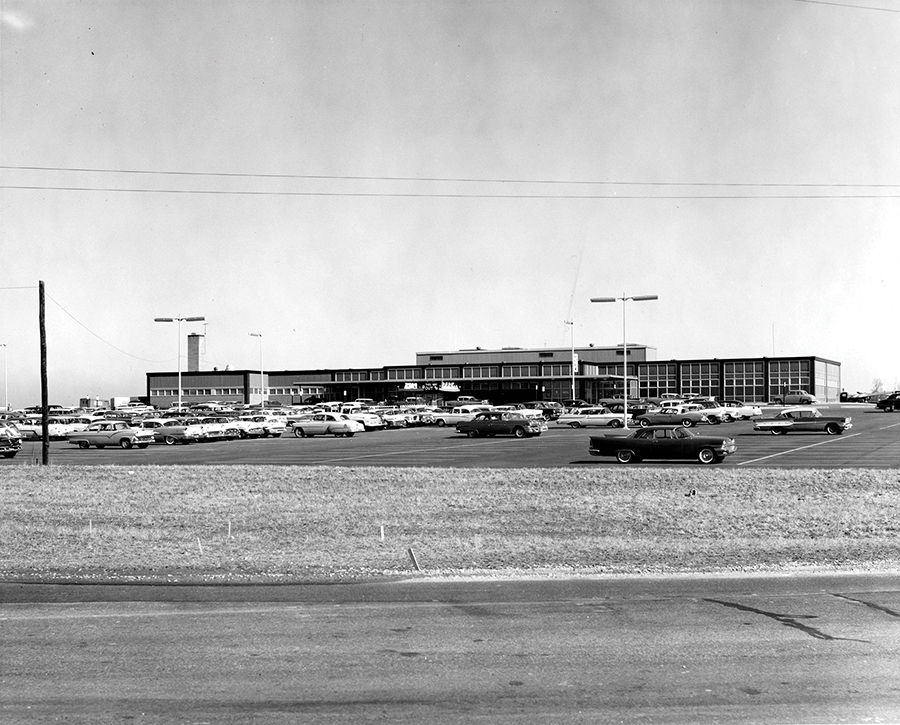
© Carol W. Martin/Greensboro History Museum Collection
According to my dear friend, Margaret Underwood, it was at this out-of-the-way Italian eatery overlooking the tarmac at PTI that chef Steve Bartis, another Greek expat, served the Gate City’s first pizza pie back in the 1950s. According to Margaret, this joint, with a $2.25 Wednesday night buffet, “had the best tossed salads with Roquefort dressing I’ve ever tasted.”
8) Tom Tom Supper Club
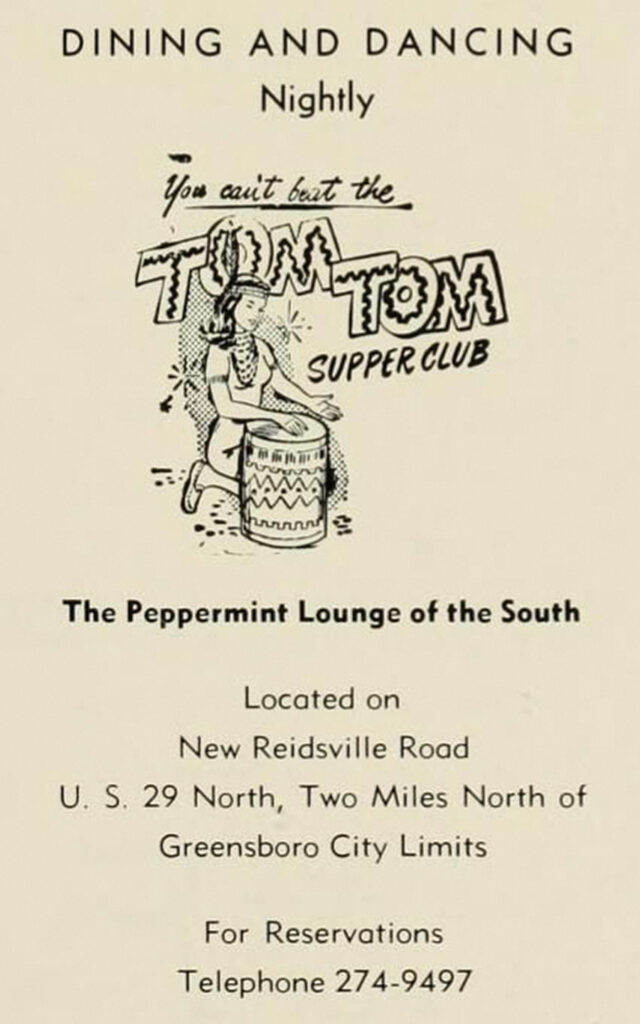
From the 1940s well into the 1970s, supper clubs were all the rage. Communal dining and dancing in grand ballrooms accompanied by live entertainment dished out by B- and C-listers such as Gogi Grant, The Archers, aka “America’s Answer to the Beatles!,” and alleged comedian Joe E. Ross’ wretched stand-up act. In Greensboro alone there were over half-a-dozen supper clubs during the 1960s with names like Queen’s Inn, Canopy, Tropicana (borderline strip joint booking acts such as Ginger “Snapper” Monroe, Exotique), Green’s — famous for its beach-themed oyster bar — and the Plantation on High Point Road (now Gate City Boulevard), where occasional A-listers, including The Ames Brothers and Nat King Cole, performed.
9) S&W Cafeteria / Mayfair Cafeteria
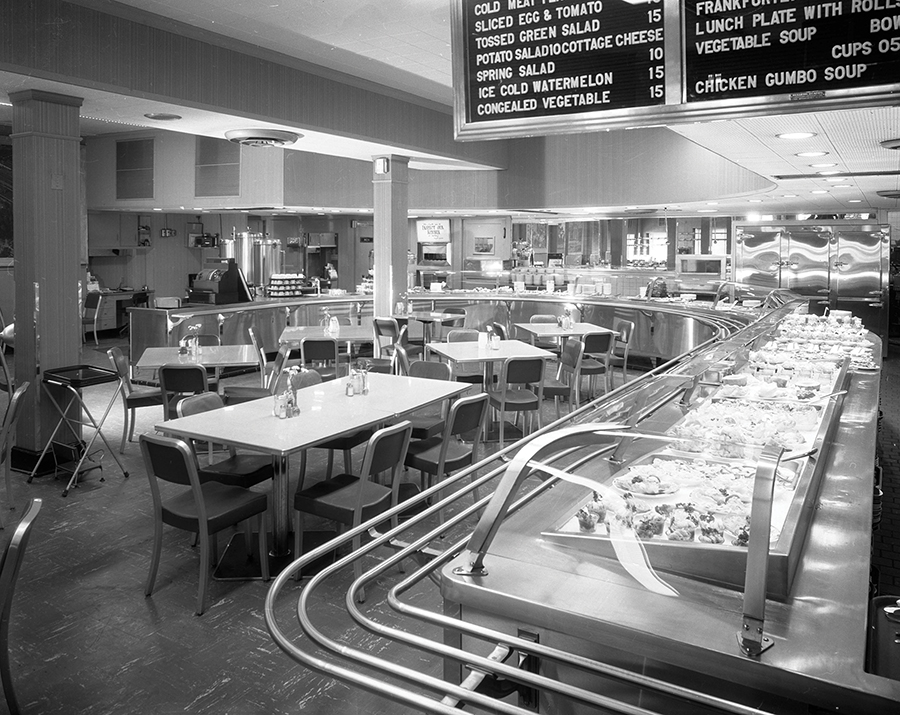
© Carol W. Martin/Greensboro History Museum Collection
Just one of many cafeterias downtown, the S&W was said to be the finest in the nation with an operation that took up three floors. Many felt it was a cut above, both culinarily and with its quietly elegant interior. Both S&W and Mayfair closed in the mid-’60s, when customers began fleeing the center of town for neighborhood retail strips, Friendly Center and, soon to follow in the ’70s, the Four Seasons Mall.
10) Sunset Hills Restaurant
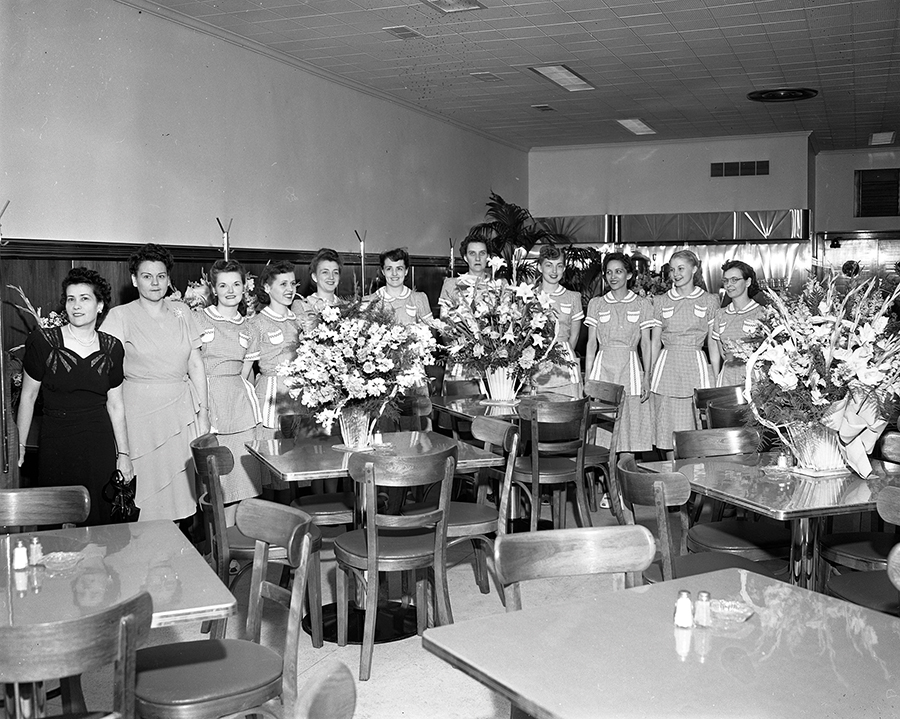
© Carol W. Martin/Greensboro History Museum Collection
A fine dining establishment named for the neighborhood it bordered, Sunset Hills Restaurant opened its doors in the 1952 at 1618 Friendly Road. Offering live lobsters, thick-cut pork chops and massive steaks served in a refined setting, it closed when the entire block was demolished in the early-1960s to accommodate a modern fire station, where 1618 West is docked currently.
11) Bliss Restaurant
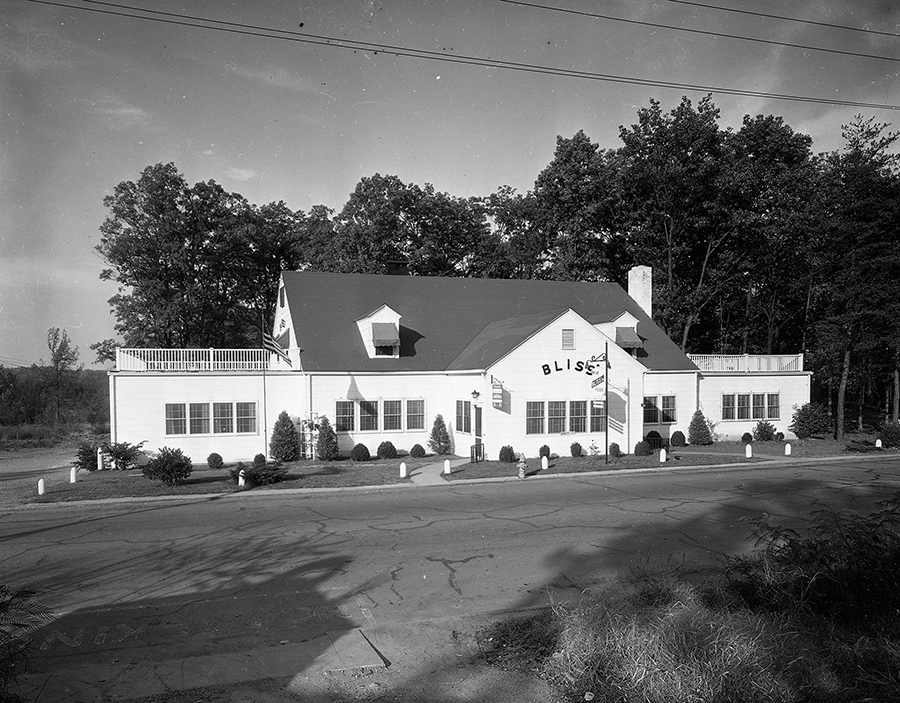
© Carol W. Martin/Greensboro History Museum Collection
From the corner of Northwood and Huntington, this fine dining establishment seared chops and steaks for the Irving Park set from the 1940s until the mid-’60s when the place, by then renamed Al Bolling’s Charcoal Steak House, was itself reduced to charcoal after an inferno leveled the structure. That location then became home to the greatest multiscreen movie theater this city has ever or will ever know, the Janus. There’s a First Citizen’s Bank there now.
12) IPD / Cellar Anton’s
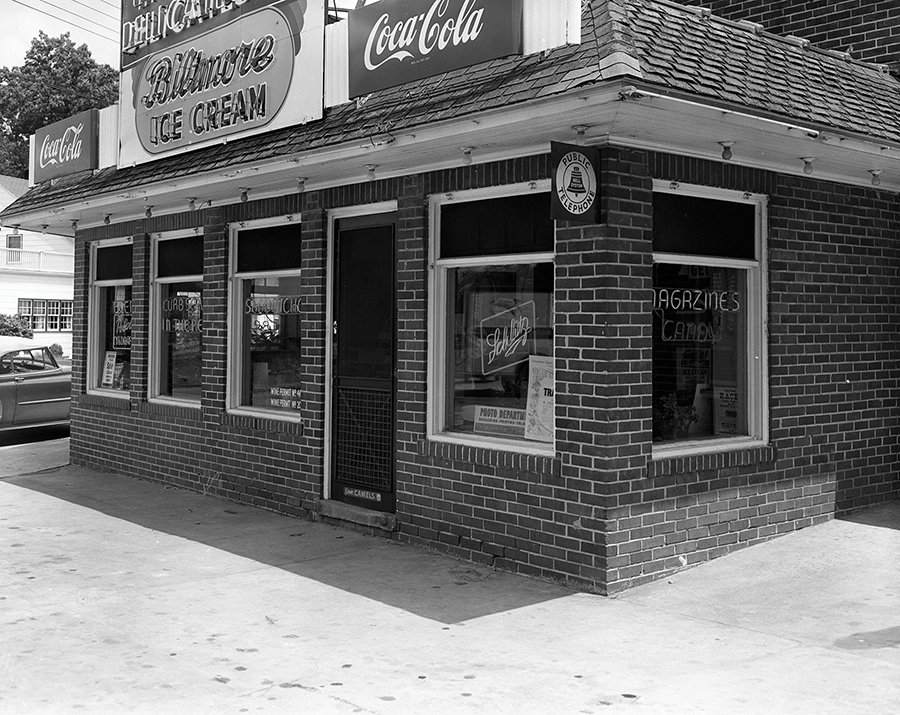
© Carol W. Martin/Greensboro History Museum Collection
Across Northwood from Bliss, Bill Anton converted a grocery store into a community culinary gathering spot like no other: Irving Park Delicatessen (IPD to regulars). The look, seen here in 1960, changed drastically in later years, but upstairs was the casual cafe where beloved waitress Bertie Johnson warmly welcomed folks, serving up lasagna and beef Leonardo that couldn’t be beat. Downstairs, where maître d’ Fitz Fitzgerald presided, was the more upscale Cellar Anton’s, a cavernous, candlelit old world grotto dominated by a wooden bar for folks “brown bagging.” At the time diners brought their own liquor to be stored behind the bar, then paid a nominal fee for set-ups. When IPD closed a decade ago, an extraordinarily crucial manifestation of what defined Old Greensboro vanished along with it.
13) Casey’s “World’s Best Bar-B-Q”
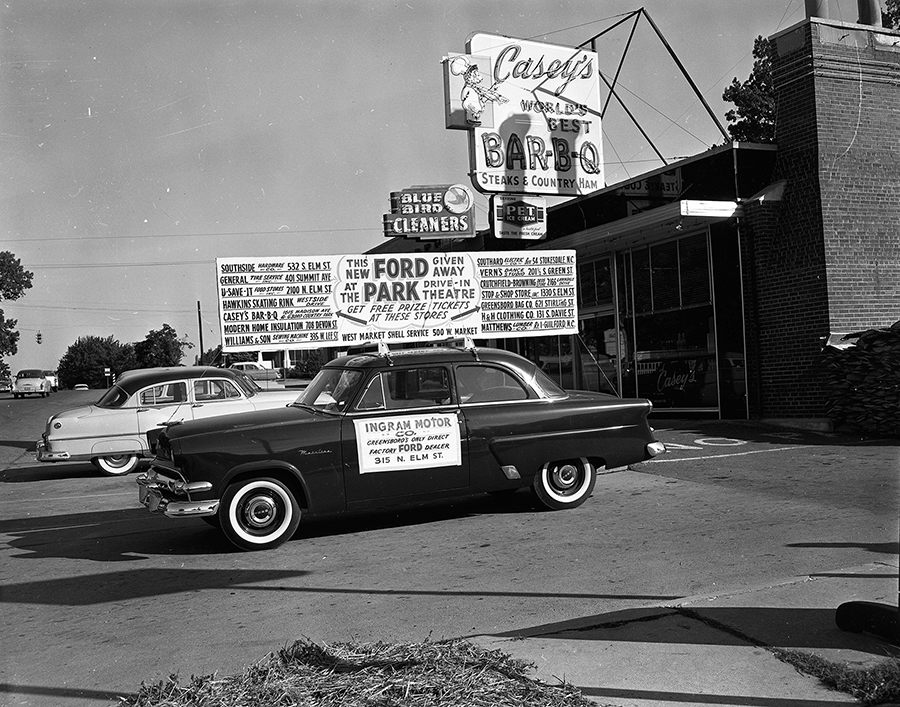
© Greensboro History Museum
Very popular with the Grimsley High lunch crowd from the ’50s into the ’70s, Casey’s was known for its grab-and-go Whiz Burgers, so named because the patties were slathered in Cheez Whiz. Booths were equipped with tabletop jukeboxes and prominently displayed up front was a check for $5,000 (more than $50,000 adjusted for inflation) signed by Andy Griffith for catering a Los Angeles cast party. He’d wanted his TV co-stars and crew to experience authentic North Carolina barbecue. You may recognize this building — it’s the strip on Friendly where Bandito Bodega is today.
14) Honey’s Drive-In
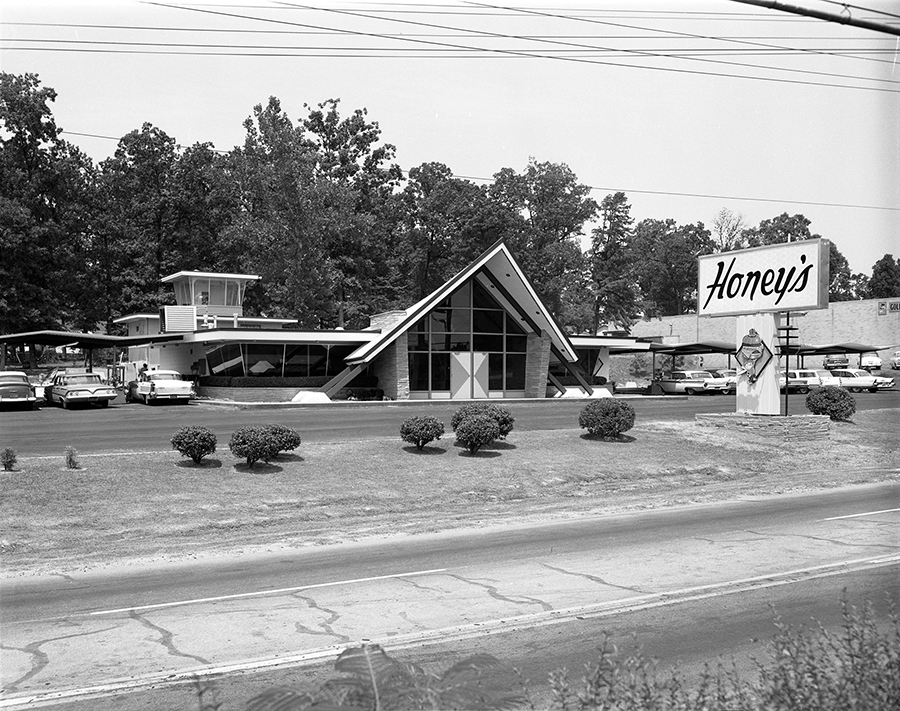
© Carol W. Martin/Greensboro History Museum Collection
With car culture in full swing by the 1950s, cruising High Point Road became a requisite teenage pastime. So the idea of downing King Bee burgers with your date sitting close enough to share your shake in an automobile the size of a small living room made perfect sense. Immaculately coiffed car hops attended to mobile meal-goers, while indoor noshers placed orders via closed-circuit telephone. Behind Honey’s (previously McClure’s) was the fabled Sky Castle, where Greensboro’s grooviest rock’n’roll radio jocks broadcasted live over 1320-AM WCOG. DJs would even take requests from diners as they tuned in while eating, parked in their beaters and crates. A great deal more exciting than current tenant Olive Garden.
15) McClure’s
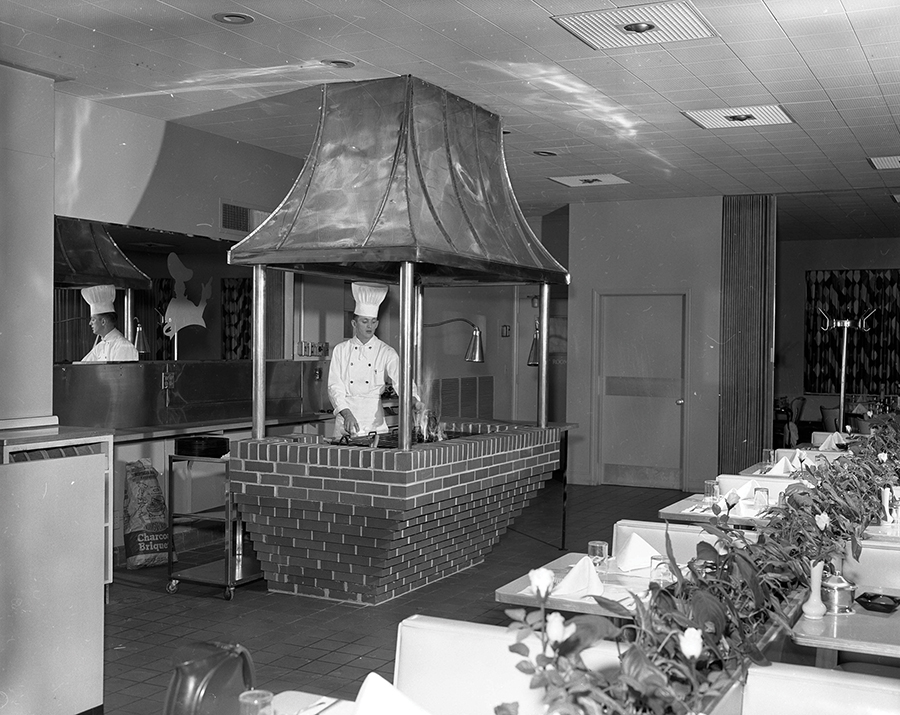
© Carol W. Martin/Greensboro History Museum Collection
After Drew and Devore McClure sold the aforementioned drive-in, they opened this upmarket restaurant around 1964 in the Summit Shopping Center. It was considered the height of mid-century elegance, featuring the “Sir Loin Room,” where rare roast beef was carved to order. A lobster tank anchored the front window, while, in the rear, the comfy Lantern Lounge with tufted leather seating showcased local musical acts on weekends. Very Continental.
16) Jung’s
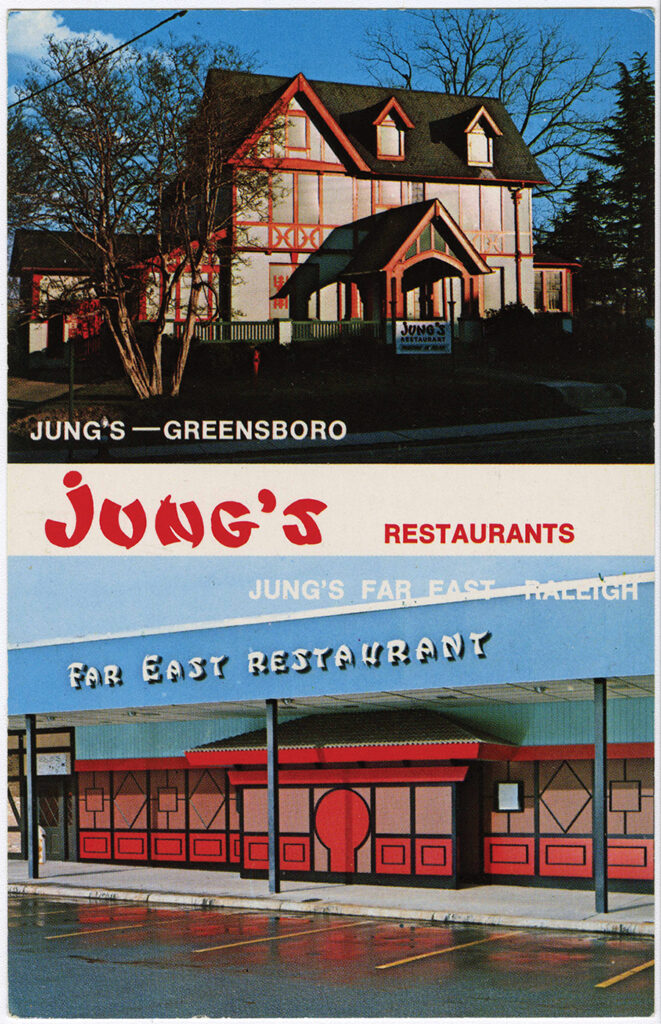
© Greensboro History Museum
In the 1970s and ’80s, this Tudor-inspired house at 314 North Church St. was one of the city’s superlative dining destinations. While Jung’s Chinese & American Restaurant featured beautiful, spacious dining rooms with high ceilings, when I would tag along with my father, he would generally order Chinese spare ribs to-go.
17) Jordan’s Steak House
Jordan’s Steak House, established in 1972, featured an intimate, 76-seat isle of gentility on Church Street, masked by a nondescript exterior. The most sought after chophouse in the Triad for visitors during High Point Furniture Market, its limited menu ensured exceptional standards. Diners selected the cut of beef they desired from a rolling table-side cart and, in due time, that steak returned grilled to perfection. By 1999, it was well-done the moment mediocre meat merchants Outback and Longhorn rode into town uninvited.
18) Darryl’s 1890
For teenagers in the 1970s, Darryl’s was the place to congregate with friends over frosty $3 pitchers and cheap wine carafes. Immersed in a playfully garish decor obviously inspired by New Orleans cathouses, the atmosphere was unlike any other, almost every station adorned with its own singular theme. The most requested corner was the caged table resembling a jail cell. Lines were long as eager date-nighters clambered to get inside on weekends.
19) Tony’s Pizza
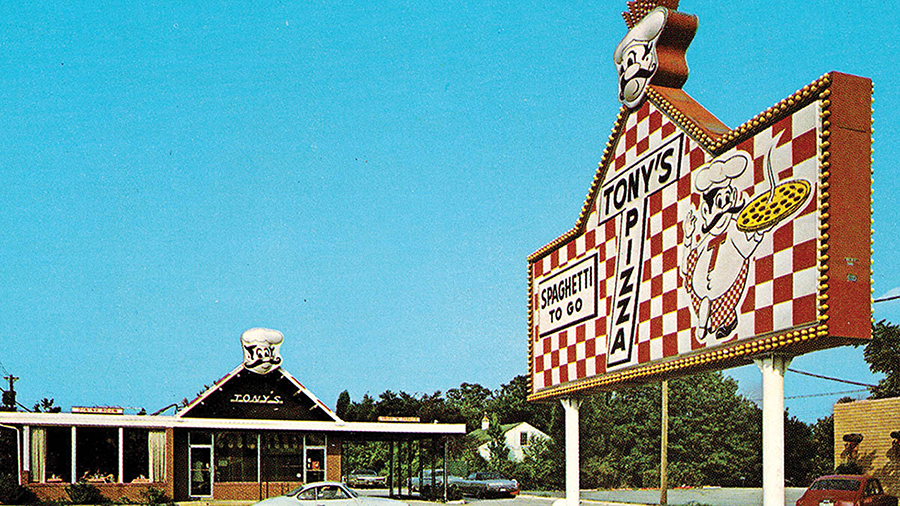
Another hip hangout for high schoolers in the 1970s was Tony’s Pizza on Battleground, an avenue nowhere resembling the congested corridor of car lots and fast food chains we’re accustomed to today. Conceived and owned by Aleck Alexiou, son of The Princess Cafe’s owner, Tony’s was known for its incredible submarine and grinder sandwiches, a relatively new concept for this region.
20) Baskin-Robbins
Can one wax nostalgic over a franchise store in a cinderblock hut? In the 1970s, after movies let out at the Janus Theatres, Baskin-Robbins’ parking lot on Battleground behind IPD became packed tighter than a BR pint, brimming with young people. Business was so brisk Janus launched its own ice cream parlor that failed to dampen the throngs amassing nightly in search for affection over confection anyway. After the Janus’ eight screens flickered out in 2000, the crowds melted away at 31 Flavors, resulting in its slow demise.
As an amuse bouche, here’s a partial list of restaurants that have been around for 45 years or more, still in their original locations, that remain highly recommended: Cafe Pasta; Bernie’s Bar-B-Q; Brown-Gardiner Drug Store’s lunch counter; Lucky 32; Yum-Yum Better Ice Cream; K&W Cafeteria; Lox, Stock & Bagel; First Carolina Delicatessen; Mayberry Ice Cream; and New York Pizza on Tate. OH
